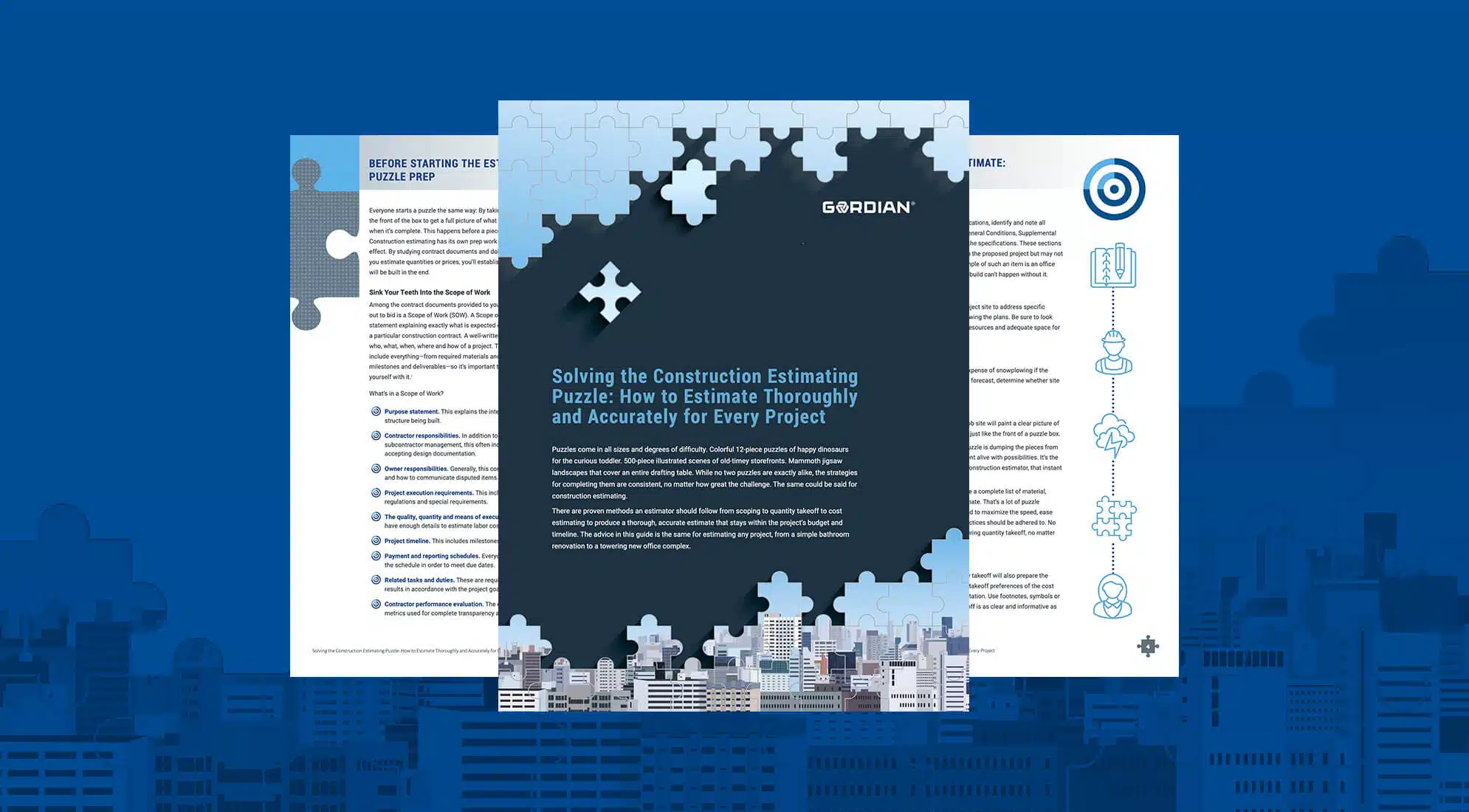In bowling and golf, a slight flick of the wrist or unaccounted for breeze could really change your game. Construction estimating is no different. It’s a precision sport, a scientific, mathematical process full of strategy. Just like swinging a driver or rolling a bowling ball, one miscalculation will drastically alter the end result. Small mistakes can make a big impact.
Once a construction cost estimate is complete from the scientific end, estimators and the management team need to go a step further to make sure it reflects real market conditions. Otherwise, the bid won’t be competitive and the job will be lost. It’s important for estimators to communicate openly with the financial and management teams at the construction company to keep costs accurate and ultimately make money on the project. Gordian recently produced a webinar in partnership with Engineering News Record (ENR) where estimating expert Chris Randall discussed strategies to adjust estimates to market conditions so estimators, contractors and other construction professionals can avoid gutter balls and bogeys.
Trending Estimates
Trend analysis is the practice of collecting information and examining it to discover patterns. In golf, that might mean watching video of your swing to find out why sometimes you hit the ball right down the fairway and other times you slice it into the rough. In construction estimating, it’s important to compare past results to new results in the same market timeframe.
If the summer is a very busy time for you and the cost of construction goes up, you should look back at your estimates from previous summers to see if construction costs typically fluctuate seasonally in your area. It’s a very simple but effective methodology. If you keep thorough and accurate records, using your own historical estimates as comparison tools is a good way to gauge market swings. You can organize your estimates by like projects, location, seasonality, availability of work and other categories to make comparisons quickly.
Chris Randall added a quick note to stay disciplined with your estimates to avoid subjecting your company to a lot of risk. You should also compare your bids against reputable competitors. If you know other companies or firms that bid similarly to yours and you’re able to capture the results of your projects, then you can compare against them. You can measure if competitors’ prices are increasing or decreasing, which correlates directly to the strength of the market. You should also compare against weaker or slower bidding cycles. Comparing your current project to similar projects estimated in strong cycles and weak cycles allows you to trend the changes and gauge market strength.
Chris says numbers or percentages to add or subtract are different per location, discipline of work, types of contractors — everything. But, mid-level or senior estimators should be trending all of their work through constant, meticulous record keeping. When you trend your estimates, you can use them as a guide to quickly discover errors or further validate your work.
Trending Project Performance
Another elemental and critical part of analyzing your work is to trend project performance. You should always compare your estimate against job results. Did the job make money or lose money? Was that a result of the estimate? Was there a crucial change in market conditions that caused the estimate be inaccurate or was something just forgotten? Mistakes are meant for learning, not repeating. The answers to these questions are crucial and should help inform your future estimates.
Consider job performance factors in your analysis. This could be anything from labor, material and equipment availability to the cost of insurance or construction loans and other factors. Anything that affects job performance and is directly influenced by the industry is fair game for analysis, so keep market and economic trends in mind.
Another rule of thumb technique that many senior estimators use is to develop your own pricing cross-checks. For example, if you’re bidding an elementary school this year that is 100,000 square feet and then bidding another school months apart that is 150,000 square feet, is the cost one and a half times what it was for your first project? This should help to gauge the accuracy of your new estimate.
Speaking of Accuracy
Better data makes for better estimates. Chris Randall often uses RSMeans Data from Gordian to create his estimates. As the industry standard for construction costs since the 1940s, RSMeans Data is accurate and up-to-date construction cost information that helps owners, architects, cost engineers, contractors and others precisely project and control the costs of both new building construction and renovation projects.
Here is what Chris Randall has to say about estimating with RSMeans Data from Gordian:
- Reference local labor costs and productivity rates. “RSMeans Data is the industry-accepted local labor data. It’s very, very good for that and also has productivity rates for particular areas.”
- Validate historical costs with up-to-date cost data. “We talked about trending your estimating costs. RSMeans Data does a great job at trending material costs years and years back. Everything is up to date with the current cost data but it also goes way back for historical reference.”
- Fill knowledge gaps for unfamiliar scopes, markets and trades. “If you’re unfamiliar with particular trades that will be part of your overall project, RSMeans Data is excellent for that. It really does make it a lot easier for estimators who are not familiar with a particular type of trade. Rather than just give you labor and material costs, it breaks it down into much greater detail and to a level of easier understanding for you as you put your estimate together.”
- Create square foot cost estimates to reduce errors or omissions. “We talked about square footage and cross-checking your estimate. RSMeans Data has a square foot calculator that is very, very good. You may be doing a budget proposal for a large building and you can use that square footage. Is that the final number you’re going to use to put a proposal together — no, absolutely not. Are you going to cross-check a big estimate using the square foot calculator — yes, absolutely! It’s a fantastic idea and gives you a great guideline to see how your numbers stack up.”
Precision Tools for Construction Estimating
RSMeans Data cost books, CDs and RSMeans Data Online provide great tools for quick estimates and cost validation and are localized, accurate and complete. Chris adds, “If there are discussions with an owner, designer or construction manager about the validity of your cost data, using RSMeans Data is really the trump card when it comes to estimating. I’m very glad to use it.”
Like golf or bowling, construction estimating is a precision sport — it takes discipline, practice and control to hit the mark consistently. To learn more details about key strategies for adjusting estimates with real-world market conditions in mind, access the on demand webinar Gordian sponsored in partnership with ENR titled “Making Estimates Realistic to Market Conditions.”






